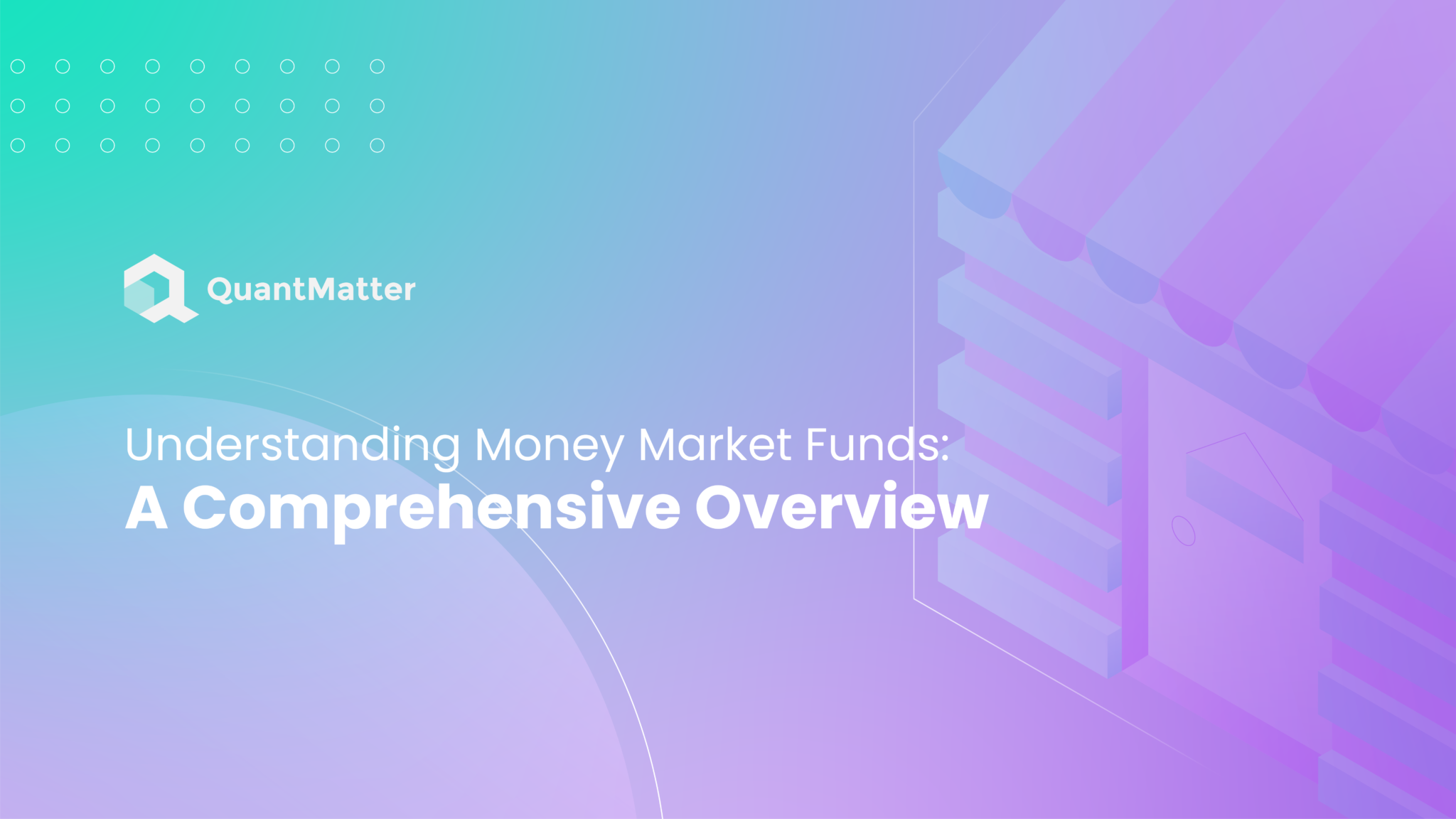
Money market funds (MMFs) occupy a key position, providing investors with simple liquidity and safe stability allied to modestly attractive returns. With a perfect combination of safety and yield, money market funds enjoy an exclusive position in the financial environment. This equilibrium gives them an important role to play as a diversified component in any investment portfolio.
One reason why money market funds are so popular is that their definition requires them to maintain capital preservation. They achieve this through investments in short-term, high quality debt securities like Treasury bills and commercial paper as well as certificates of deposit (also called banker’s acceptinghouses). At the same time, they provide a low return yield which can serve as an alternative to traditional savings accounts. The purpose of this article is to grasp money market funds, and explore their characteristics, benefits and considerations for investors.
What are Money Market Funds?

Money market funds are unique investment vehicles; they place predominately in short-term, high quality debt securities. Financial instruments include a large variety of assets–Treasury bills and commercial paper to certificates of deposit, but in every case the maturities are short. Basically, the purpose of MMFs is to provide investors with a channel in which they can invest without much risk and possibly earn some return.
MMFs are based on conservative investment styles that place emphasis on the stability and liquidity characteristics of short-term financial products. Because treasury bills are obligations of the government and thus relatively risk-free, money market funds toward your good friend Ingram. MMFs have a very well-balanced portfolio, and to help achieve this corporations also issue commercial paper while banks generally offer certificates of deposit.
Moreover, because these debt securities are short term in nature, the fluctuations in their value relative to more long-term investments like stocks tend to be relatively small. This feature is consistent with the objective of risk mitigation. It appeals to investors seeking stability and preservation of capital. Nonetheless, it is important to note that although the risk has been reduced, MMF returns are proportionately low and complementary as well. They really only suit conservative investors or people who have short-term liquidity needs.
Also Read: Market Making: Strategies and Techniques
In addition, how MMFs are regulated has a major impact on their workings. Guidelines are often strict, imposed by various regulatory bodies to ensure the stability and integrity of these funds. For example, they might prescribe the highest maturity and lowest-grade holdings of securities that can be kept within a fund to help guarantee an appropriate balance in line with the risk profile of intended.
Money market funds are an excellent choice for investors looking to achieve a balance between security and returns in the short term world of financial assets. With a diversified portfolio of high-quality debt securities, combined with an emphasis on liquidity and risk management assures them first place among those looking for stability in their investment strategy.
Key Features of Money Market Funds

Money market funds (MMFs) boast several key features that contribute to their appeal and utility in the investment landscape:
– Diversification
Risk management is fundamental to money market funds ( MMFs). Diversification is a cornerstone. MMFs attain diversification with their investments in different short-term, creditworthy paper. These include Treasury bills, commercial papers and certificates of deposit (CD). By holding a diversified portfolio, risk is spread among different issuers and types of securities. The fund therefore insulates itself against the impact that defaults may have on individual holdings.
Because MMFs are diversified in their holdings of assets, they help maintain stability during periods when market sentiment is uncertain. And for the more risk-averse investor whose attitude between safety and a reasonable return has become one sitting on its hands, investment firms proclaim them to be an ideal choice. Choosing different instruments provides MMFs added flexibility in facing up to economic cycles. This helps the credibility of these investment vehicles over all, as well.
– Net Asset Value (NAV) Stability
One of the characteristics that makes MMFs unique is their commitment to maintaining a stable Net Asset Value (NAV). These are stable funds, with the NAV commonly maintained at $ 1 per share. They achieve this stability by means of stringent investment strategies, including short-term securities with low price fluctuations. The use of conservative instruments like government-assured Treasury bills makes MMF valuations relatively predictable.
This reminder brings reassurance to investors, particularly those inclined more toward capital preservation. Their investment in an MMF will retain a definite value. A stable NAV makes MMFs appear to investors as a secure, reliable investment. This helps attract people who want their holdings’ worth kept within narrow limits and seek predictable valuations of what they own. However, during times of broader market uncertainty this feature is especially important to giving investors confidence.
– Regulatory Oversight
The regulatory oversight in place for MMFs is thus an important factor contributing to the stability and integrity of this type of investment vehicle. Guidelines governing composition and management of MMFs are formulated by regulatory bodies. Such guidelines often establish maximum averages for the maturities and credit quality of the securities within a fund. This is like adding another layer to its risk management structure.
The objective of these regulations is to increase the level of transparency and investor protection, by prescribing certain standards that all MMFs must meet. For instance, in times of economic stress regulators might take steps to prevent a run on money market funds and thus treat all investors fairly. Also, regulatory oversight not only creates accountability; it helps engender investors’ confidence. This in turn reinforces MMFs ‘image as being both secure and well-regulated investment vehicles.
5 Money Market Funds Benefits

Money market funds (MMFs) offer a range of benefits to investors, making them a popular choice for those seeking a balance between safety, liquidity, and modest returns:
1. Safety of Principal
The most important advantage of money market funds (MMFs) is that they have never faltered in their primary objective: the safety of principal. To preserve capital, MMFs mainly invest in short-term high quality debt securities such as Treasury bills and top rated commercial paper.
This conservative investment strategy limits the possibility of a loss in capital, and for investors its relatively safe harbor. It’s particularly appealing to risk-averse people and organizations looking for low-risk investments that can maintain a stable market, provide insurance coverage on the initial investment.
2. Liquidity
Renowned for their high liquidity, MMFs allow investors to access and withdraw funds quickly. Its daily liquidity feature means that shares in MMFs can be converted into cash on a moment’s notice; thus, they are an excellent choice for those who need short-term liquidity.
Besides allowing investors to draw on their investments unexpectedly, this liquidity feature also makes MMFs an agile and adaptive ingredient in investment mixes. Sensitive to investors ‘liking for liquidity, MMFs are faster at accessing funds than investments with longer redemption periods. This is one feature that sets them apart from all other investment choices.
3. Stability and Low Volatility
The focus on very short-term, high-quality securities contributes a great deal to the stability and low volatility of MMFs. This is a major advantage for investors seeking an investment with stability and security.
The conservative investment structure of MMFs reduces exposure to fluctuations in the market, so changes in its Net Asset Value (NAV) tend to be quieter than other funds. This stability especially appeals in times of economic uncertainty, drawing investors who attach importance to a stable and safe investment environment.
4. Competitive Yields
MMFs don’t offer the highest rate of return around, but they provide competitive returns compared with traditional savings accounts. This is an especially attractive benefit in low-interest environments, when opportunities for investing money at a very low risk can be hard to come by.
The steady and respectable returns produced by MMFs offer investors the chance to strike an acceptable compromise between safety and income generation. Because of its competitive yield, MMFs are a natural choice for people and institutions wanting to maximize returns but stick within relatively safe boundaries.
5. Professional Management
Competitive advantage One unique benefit of MMFs is the professional management. Through the use of their knowledge, seasoned fund managers maneuver around these short-term debt markets. They constantly fine tune the balance between various types of securities in hopes that as economic conditions shift and interest rates rise or fall, they will get off at just the right time.
Adding a professional management layer to MMFs adds a touch of sophistication for investors, knowing that their money is being looked after by experts. These ongoing checks and changes by fund managers affect the net performance of MMFs, which is a modus operandi that investors themselves prefer in their choice between passively managed funds or actively adapted ones.
Money Market Funds Considerations
Before investing in money market funds (MMFs), investors should carefully consider a number of factors. These considerations help ensure that the investment aligns with their financial goals and risk tolerance:
– Interest Rate Environment
Knowing the environment surrounding interest rates is all important when assessing money market funds (MMFs). MMFs are also short-term investments which depend on interest rate changes. In a rising rate environment, MMFs may receive higher yields on new securities which could provide better returns for investors.
Alternatively, in a falling rate environment MMF yields will fall. Investors should keep the current interest rate environment in mind and then consider their own forecasts for future rates to assess whether MMF performance may be negatively affected within an investor’s portfolio.
Also Read: Market Maker Options: Definition and How They Make Money
– Regulatory Environment
Changes in the regulatory environment can influence drastically MMFs ‘nature. Therefore, investors should go on high alert over regulatory developments that could affect fund operations or raise liquidity requirements and credit quality standards.
Regulatory reforms determine the risk and return aspects of MMFs, so it pays to keep your eyes open. take pre-emptive steps to prevent runs on MMFs, and protect investor interests. Take periods of financial stress for example, because the money market fund landscape changes so regularly, it is very important for investors to understand and flexibly adjust in response to a complex regulatory environment.
– Credit Risk
Though MMFs concentrate on high-grade debt securities, they are not free of credit risk. The securities in an MMF’s portfolio should be analyzed carefully for credit quality.
Credit ratings, evaluating issuers financial health, and understanding credit risk are the three key factors. Even among the conservative offerings of money market investments, differences in credit quality affect the balance sheet as a whole. Evaluating credit risk properly can prevent investors from making poor investments because they have unrealistic expectations for safety or for high yields.
Money Market Funds Trends
Money market funds (MMFs) exhibit several notable trends in response to evolving market dynamics and investor preferences:
1. Ultra-Short Duration Funds
The move toward ultra-short duration funds in the money market universe is a response to investors’ desire for prudence and yield–finely balanced. They tend to hold securities with a longer average maturity than traditional money market funds. This enables them to offer slightly higher returns while still focusing on capital conservation.
With the potential for slightly higher yields without investing in longer-term assets, ultra-short duration funds offer such an investment appeal than when invested cash is only yielding its low current interest rate. This is the result of continuing difficulty in making returns cautiously, and targets those who are willing to take on a marginally higher level of risk for an equivalent increase in yield.
2. Digitalization and Online Platforms
Such digitalization of financial services has changed profoundly how investors interact with money market funds. Thanks to online platforms and fintech solutions, investing in money market funds is now easier than ever for investors–reseraching on investment target companies, buying shares of fund units after reviewing price trends and deciding how much to invest.
Such user-friendly interfaces make these platforms more accessible, and draw in a larger variety of individual investors to take part in money market funds. This aligns with the larger trend of decentralizing finance, smashing traditional walls and giving investors control over their short-term investments. Besides making things more convenient, the digitalization of money market funds also brings an increase in transparency which can help investors make better decisions at any time and from anywhere.
3. ESG Integration
Money market funds’ variety of approaches to ESG investing reflects a wider movement toward sustainable investment. In response to the rising interest in responsible finance, some money market funds are now incorporating ESG criteria into their investment strategies.
This shift recognizes that short-term investments also have the potential to be vehicles of good, as investors increasingly desire for their financial choices to reflect their own values. The inclusion of ESG criteria in money market funds represents a pledge to responsible investment, and furthermore responds well to the needs of investors which are becoming increasingly concerned about all elements surrounding their capital as it does not add any risks or costs.
4. Government Money Market Funds Dominance
Because government money market funds are safer and more stable than other types, they have been pushed to the forefront of investment circles today. These are very liquid funds which investors turn to in times of economic uncertainty, protecting their short-term cash.
The prevalence of government money market funds suggests that people are risk-averse. For them, the preservation of principal is more important than earning higher returns. This trend shows a quest for the stability guaranteed by government-issued securities; these funds are thus an important ingredient in conservative investment portfolios.
Conclusion
To really derive the full value from money market funds, investors need a thorough understanding of their characteristics and benefits-as well as cautions. Money market funds are high-security products that provide a safe harbor to investors who need stability in the short term. Another characteristic feature of these investment plans is their liquidity. That’s to say, they are an excellent choice for potential investors who have immediate cash requirements.
Moreover, money market funds also offer attractive yields (although not as high for the more risky investments), so they are in many ways an ideal compromise between safety and income. Aligning money market funds with specific financial needs requires understanding of factors such as interest rate environments, regulatory changes and liquidity requirements–considerations that apply just the same to other types of investment. Through studying the details of these funds, investors can make enlightened choices that suit individual financial needs and risk appetite.
Disclaimer: The information provided by Quant Matter in this article is intended for general informational purposes and does not reflect the company’s opinion. It is not intended as investment advice or a recommendation. Readers are strongly advised to conduct their own thorough research and consult with a qualified financial advisor before making any financial decisions.

I craft stories that make complex ideas clear. I simplify the blend of data science, machine learning, and crypto trading, showcasing how advanced tech and quantitative models analyze data for informed trading choices. Join me in exploring the realm of quantitative trading, where my narratives make intricate concepts easy to grasp.
- Alifia Berizkyhttps://quantmatter.com/author/alifia-berizky/
- Alifia Berizkyhttps://quantmatter.com/author/alifia-berizky/
- Alifia Berizkyhttps://quantmatter.com/author/alifia-berizky/
- Alifia Berizkyhttps://quantmatter.com/author/alifia-berizky/
